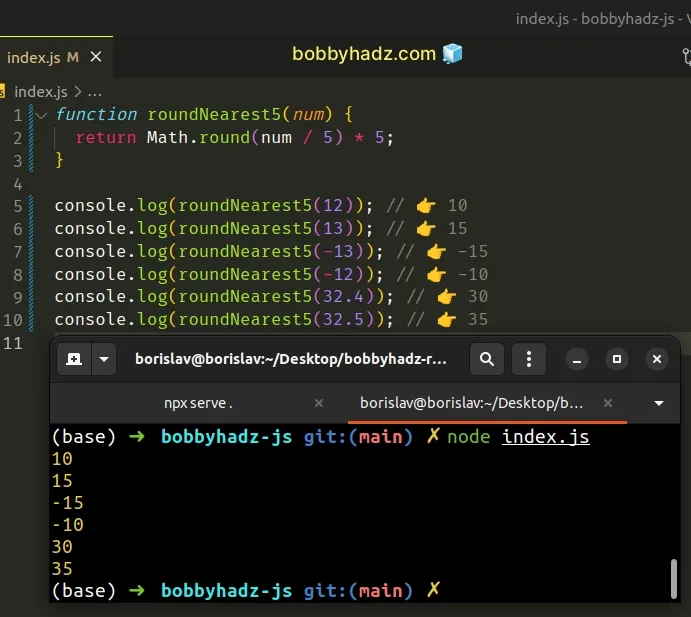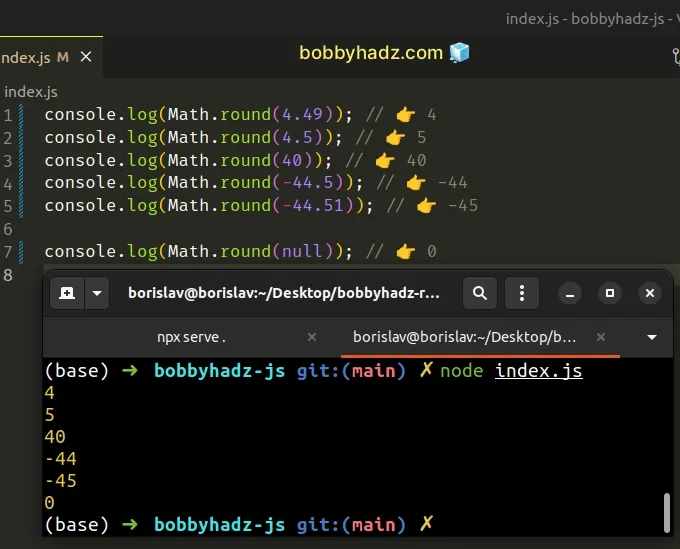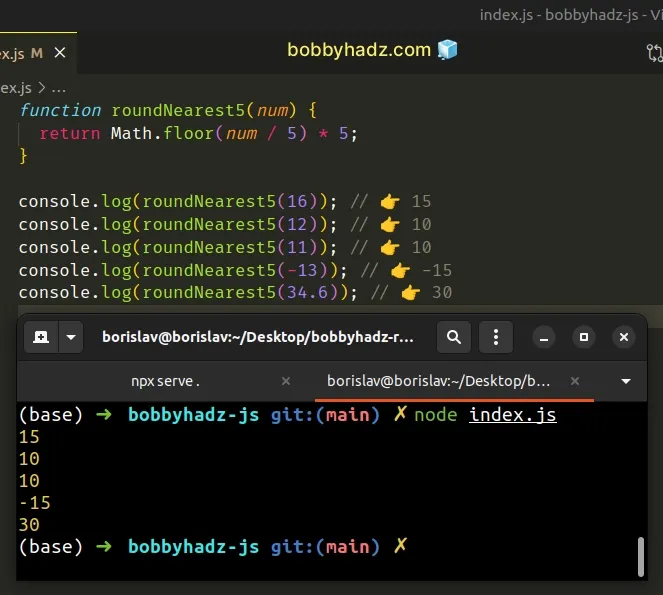Round a Number to the Nearest 5, 10 or 100 in JavaScript
Last updated: Mar 3, 2024
Reading time·8 min

# Table of Contents
- Round a Number to the Nearest 5 in JavaScript
- Round a Number to the Nearest 10 in JavaScript
- Round a Number to the Nearest 100 in JavaScript
Make sure to click on the correct subheading depending on if you need to round to the nearest
5,10or100.
# Round a Number (up or down) to the Nearest 5 in JavaScript
To round a number to the nearest multiple of 5:
- Call the
Math.round()method with the result of dividing the number by5. - Multiply the result by
5. - The
Math.round()method takes a number and rounds it to the nearest integer.
function roundNearest5(num) { return Math.round(num / 5) * 5; } console.log(roundNearest5(12)); // 👉️ 10 console.log(roundNearest5(13)); // 👉️ 15 console.log(roundNearest5(-13)); // 👉️ -15 console.log(roundNearest5(-12)); // 👉️ -10 console.log(roundNearest5(32.4)); // 👉️ 30 console.log(roundNearest5(32.5)); // 👉️ 35

Math.ceil method from the next subheading.The Math.round() method takes a number and rounds it to the nearest integer.
0.5, it gets rounded to the next higher absolute value.If the number is positive and its fractional portion is less than 0.5, it gets
rounded to the lower absolute value.
Here are some examples of using the Math.round() method.
console.log(Math.round(4.49)); // 👉️ 4 console.log(Math.round(4.5)); // 👉️ 5 console.log(Math.round(40)); // 👉️ 40 console.log(Math.round(-44.5)); // 👉️ -44 console.log(Math.round(-44.51)); // 👉️ -45 console.log(Math.round(null)); // 👉️ 0

Math.round function is invoked with a null value, it returns 0.This is how we round a number to the nearest multiple of five in a step-by-step process.
console.log(12 / 5); // 👉️ 2.4 console.log(13 / 5); // 👉️ 2.6 console.log(Math.round(12 / 5)); // 👉️ 2 console.log(Math.round(13 / 5)); // 👉️ 3 console.log(Math.round(12 / 5) * 5); // 👉️ 10 console.log(Math.round(13 / 5) * 5); // 👉️ 15
This is a two-step process:
- Divide the number by
5and round the result to the nearest integer. - Multiply the result by
5to get the number rounded to the nearest5.
The Math.round() function handles all the heavy lifting for us.
# Round a Number UP to the next multiple of 5 in JavaScript
The process of rounding up to the next multiple of 5 is:
- Call the
Math.ceil()method with the result of dividing the number by5. - Multiply the result by
5. - The
Math.ceil()method takes a number and rounds it to the nearest integer.
function roundNearest5(num) { return Math.ceil(num / 5) * 5; } console.log(roundNearest5(16)); // 👉️ 20 console.log(roundNearest5(12)); // 👉️ 15 console.log(roundNearest5(11)); // 👉️ 15 console.log(roundNearest5(-13)); // 👉️ -10 console.log(roundNearest5(32.4)); // 👉️ 35

The Math.ceil() method rounds the provided number up returning the smallest integer greater than or equal to the given number.
console.log(Math.ceil(5.0001)); // 👉️ 6 console.log(Math.ceil(5.999)); // 👉️ 6
This is how we round a number up to the next multiple of five in a step-by-step process.
console.log(12 / 5); // 👉️ 2.4 console.log(19 / 5); // 👉️ 3.8 console.log(Math.ceil(12 / 5)); // 👉️ 3 console.log(Math.ceil(19 / 5)); // 👉️ 4 console.log(Math.ceil(12 / 5) * 5); // 👉️ 15 console.log(Math.ceil(19 / 5) * 5); // 👉️ 20
This is a two-step process:
- Divide the number by
5and round the result up, to the nearest integer. - Multiply the result by
5to get the number rounded up to the next multiple of5.
# Round a number DOWN to the nearest multiple of 5 in JavaScript
You can use the Math.floor() method to always round the number down to the
nearest multiple of 5.
function roundNearest5(num) { return Math.floor(num / 5) * 5; } console.log(roundNearest5(16)); // 👉️ 15 console.log(roundNearest5(12)); // 👉️ 10 console.log(roundNearest5(11)); // 👉️ 10 console.log(roundNearest5(-13)); // 👉️ -15 console.log(roundNearest5(34.6)); // 👉️ 30

The Math.floor() method rounds the number down returning the largest integer that is smaller than or equal to the given number.
console.log(Math.floor(5.99)); // 👉️ 5 console.log(Math.floor(5.01)); // 👉️ 5
All we had to do was replace the call to the Math.round() and Math.ceil()
methods with Math.floor() to round the number down to the nearest multiple
of 5.
# Table of Contents
# Round a Number to the nearest 10 in JavaScript
To round a number to the nearest multiple of 10:
- Pass the number divided by
10to theMath.round()function. - Multiply the result by
10. - The
Math.round()function takes a number and rounds it to the nearest integer.
function roundToNearest10(num) { return Math.round(num / 10) * 10; } console.log(roundToNearest10(71)); // 👉️ 70 console.log(roundToNearest10(79.9)); // 👉️ 80 console.log(roundToNearest10(70.01)); // 👉️ 70 console.log(roundToNearest10(-44)); // 👉️ -40 console.log(roundToNearest10(-46)); // 👉️ -50
The Math.round() method takes a number and rounds it to the nearest integer.
0.5, it gets rounded to the next higher absolute value.Here are some examples of using the Math.round() method.
console.log(Math.round(7.49)); // 👉️ 7 console.log(Math.round(4.5)); // 👉️ 5 console.log(Math.round(30)); // 👉️ 30 console.log(Math.round(-34.5)); // 👉️ -34 console.log(Math.round(-34.51)); // 👉️ -35 console.log(Math.round(null)); // 👉️ 0
Math.round function is called with a null value, it returns 0.This is how we round a number to the nearest multiple of 10 in a step-by-step manner.
console.log(21 / 10); // 👉️ 2.1 console.log(40 / 10); // 👉️ 4 console.log(Math.round(21 / 10)); // 👉️ 2 console.log(Math.round(40 / 10)); // 👉️ 4 console.log(Math.round(21 / 10) * 10); // 👉️ 20 console.log(Math.round(40 / 10) * 10); // 👉️ 40
The code consists of 2 steps:
- Divide the number by
10and round the result to the nearest integer. - Multiply the result by
10to get the number rounded to the nearest10.
The Math.round() function handles all the heavy lifting for us.
# Round a Number UP/Down to the Nearest 10 using Math.ceil and Math.floor
The process of rounding up/down to the nearest 10 is:
- Use the
Math.ceil()function to round the number up to the nearest multiple of 10. - Use the
Math.floor()function to round the number down to the nearest multiple of 10.
// ✅ Round a number UP to the nearest 10 function roundUpNearest10(num) { return Math.ceil(num / 10) * 10; } console.log(roundUpNearest10(71)); // 👉️ 80 console.log(roundUpNearest10(79.9)); // 👉️ 80 console.log(roundUpNearest10(70.01)); // 👉️ 80 console.log(roundUpNearest10(-49)); // 👉️ -40 console.log(roundUpNearest10(-50)); // 👉️ -50 // ---------------------------------------------- // ✅ Round a number DOWN to the nearest 10 function roundDownToNearest10(num) { return Math.floor(num / 10) * 10; } console.log(roundDownToNearest10(39)); // 👉️ 30 console.log(roundDownToNearest10(31)); // 👉️ 30 console.log(roundDownToNearest10(399.999)); // 👉️ 390 console.log(roundDownToNearest10(-409)); // 👉️ -410 console.log(roundDownToNearest10(-401)); // 👉️ -410
The first function rounds a number up to the next multiple of 10 and the second rounds a number down to the nearest 10.
When rounding up, the Math.ceil() function handles the heavy lifting for us.
Math.ceil function rounds the number up.If an integer is passed, the function simply returns the number as is.
Here are some examples of using the Math.ceil() function.
console.log(Math.ceil(7.01)); // 👉️ 8 console.log(Math.ceil(71.00001)); // 👉️ 72 console.log(Math.ceil(70)); // 👉️ 70 console.log(Math.ceil(-23.99)); // 👉️ -20 console.log(Math.ceil(null)); // 👉️ 0
Math.ceil function is invoked with a null value, it returns 0.Here is a step-by-step process of rounding a number up to the next multiple of 10.
console.log(21 / 10); // 👉️ 2.1 console.log(40 / 10); // 👉️ 4 console.log(Math.ceil(21 / 10)); // 👉️ 3 console.log(Math.ceil(40 / 10)); // 👉️ 4 console.log(Math.ceil(21 / 10) * 10); // 👉️ 30 console.log(Math.ceil(40 / 10) * 10); // 👉️ 40
There are 2 steps in the code:
- Divide the number by
10and round the result up to the next largest integer. - Multiply the result by
10to get the number rounded up to the nearest10.
If you need to round a number down to the nearest multiple of 10, use the
Math.floor() function.
function roundDownToNearest10(num) { return Math.floor(num / 10) * 10; } console.log(roundDownToNearest10(39)); // 👉️ 30 console.log(roundDownToNearest10(31)); // 👉️ 30 console.log(roundDownToNearest10(399.999)); // 👉️ 390 console.log(roundDownToNearest10(-409)); // 👉️ -410 console.log(roundDownToNearest10(-401)); // 👉️ -410
The Math.floor() function returns a number that represents the largest integer that is less than or equal to the provided number.
In other words, if the passed-in number has a fractional part, it gets rounded down to the next integer.
And if the number is an integer, the Math.floor() function returns the number
as is.
Here are some examples of using the Math.floor() function.
console.log(Math.floor(14.9)); // 👉️ 14 console.log(Math.floor(14.1)); // 👉️ 14 console.log(Math.floor(80)); // 👉️ 80 console.log(Math.floor(-14.9)); // 👉️ -15 console.log(Math.floor(-14.1)); // 👉️ -15 console.log(Math.floor(null)); // 👉️ 0
null value to the Math.floor function, it returns 0.Here is the step-by-step example from the code snippet.
console.log(39 / 10); // 👉️ 3.9 console.log(70 / 10); // 👉️ 7 console.log(Math.floor(39 / 10)); // 👉️ 3 console.log(Math.floor(70 / 10)); // 👉️ 7 console.log(Math.floor(39 / 10) * 10); // 👉️ 30 console.log(Math.floor(70 / 10) * 10); // 👉️ 70
The process consists of 2 steps:
- Divide the number by
10and round the result down to the next largest integer. - Multiply the result by
10to get the number rounded down to the nearest10.
# Round a Number (up or down) to the Nearest 100 in JavaScript
To round a number to the nearest multiple of 100:
- Pass the number divided by
100to theMath.round()function. - Multiply the result by
100. - The
Math.round()function takes a number and rounds it to the nearest integer.
function roundNearest100(num) { return Math.round(num / 100) * 100; } console.log(roundNearest100(349)); // 👉️ 300 console.log(roundNearest100(350)); // 👉️ 400 console.log(roundNearest100(175.1)); // 👉️ 200 console.log(roundNearest100(-351)); // 👉️ -400 console.log(roundNearest100(-350)); // 👉️ -300
The Math.round() method takes a number and rounds it to the nearest integer.
0.5, it gets rounded to the next higher absolute value.Here are some examples of using the Math.round() method.
console.log(Math.round(6.49)); // 👉️ 6 console.log(Math.round(6.5)); // 👉️ 7 console.log(Math.round(60)); // 👉️ 60 console.log(Math.round(-64.5)); // 👉️ -64 console.log(Math.round(-64.51)); // 👉️ -65 console.log(Math.round(null)); // 👉️ 0
Math.round function is called with a null value, it returns 0.This is how we round a number to the nearest multiple of 100 in a step-by-step manner.
console.log(250 / 100); // 👉️ 2.5 console.log(440 / 100); // 👉️ 4.4 console.log(Math.round(250 / 100)); // 👉️ 3 console.log(Math.round(440 / 100)); // 👉️ 4 console.log(Math.round(250 / 100) * 100); // 👉️ 300 console.log(Math.round(440 / 100) * 100); // 👉️ 400
The code consists of 2 steps:
- Divide the number by
100and round the result to the nearest integer. - Multiply the result by
100to get the number rounded to the nearest100.
The Math.round() function handles all the heavy lifting for us.
# Round a Number Up/Down to the Nearest 100 using Math.ceil and Math.floor
You can use the Math.ceil() method to round a number up to the next multiple
of 100.
If you need to round a number down to the nearest multiple of 100, use the
Math.floor() method.
function roundUpToNearest100(num) { return Math.ceil(num / 100) * 100; } console.log(roundUpToNearest100(101)); // 👉️ 200 console.log(roundUpToNearest100(199)); // 👉️ 200 console.log(roundUpToNearest100(100.001)); // 👉️ 200 console.log(roundUpToNearest100(-399)); // 👉️ -300 console.log(roundUpToNearest100(-301)); // 👉️ -300
The code sample above uses the Math.ceil() method to round a number up to the
next multiple of 100.
If you need to round a number down to the nearest multiple of 100, use the
Math.floor() method instead.
function roundDownToNearest100(num) { return Math.floor(num / 100) * 100; } console.log(roundDownToNearest100(101)); // 👉️ 100 console.log(roundDownToNearest100(199)); // 👉️ 100 console.log(roundDownToNearest100(100.001)); // 👉️ 100 console.log(roundDownToNearest100(-399)); // 👉️ -400 console.log(roundDownToNearest100(-301)); // 👉️ -400
If the number we passed to the Math.ceil() function has anything after the decimal, the number gets rounded up.
If an integer is passed to the Math.ceil() function, it simply returns the
number as is.
Here are some examples of using the Math.ceil() function.
console.log(Math.ceil(10.01)); // 👉️ 11 console.log(Math.ceil(19.01)); // 👉️ 20 console.log(Math.ceil(20)); // 👉️ 20 console.log(Math.ceil(-10.99)); // 👉️ -10 console.log(Math.ceil(null)); // 👉️ 0
null value to the Math.ceil function, it returns 0.Here are the steps we took to round a number up to the next multiple of 100.
console.log(601 / 100); // 👉️ 6.01 console.log(900 / 100); // 👉️ 9 console.log(Math.ceil(601 / 100)); // 👉️ 7 console.log(Math.ceil(900 / 100)); // 👉️ 9 console.log(Math.ceil(601 / 100) * 100); // 👉️ 700 console.log(Math.ceil(900 / 100) * 100); // 👉️ 900
The process consists of 2 steps:
- Divide the number by
100and round the result up to the next largest integer. - Multiply the result by
100to get the number rounded up to the nearest100.
The process is the same for rounding a number down to the nearest multiple of
100, we just have to use the Math.floor() method.
function roundDownToNearest100(num) { return Math.floor(num / 100) * 100; } console.log(roundDownToNearest100(101)); // 👉️ 100 console.log(roundDownToNearest100(199)); // 👉️ 100 console.log(roundDownToNearest100(100.001)); // 👉️ 100 console.log(roundDownToNearest100(-399)); // 👉️ -400 console.log(roundDownToNearest100(-301)); // 👉️ -400
The Math.floor() method rounds the number down returning the largest integer that is smaller than or equal to the given number.
console.log(Math.floor(7.99999)); // 👉️ 7 console.log(Math.floor(7.00001)); // 👉️ 7
# Additional Resources
You can learn more about the related topics by checking out the following tutorials:

